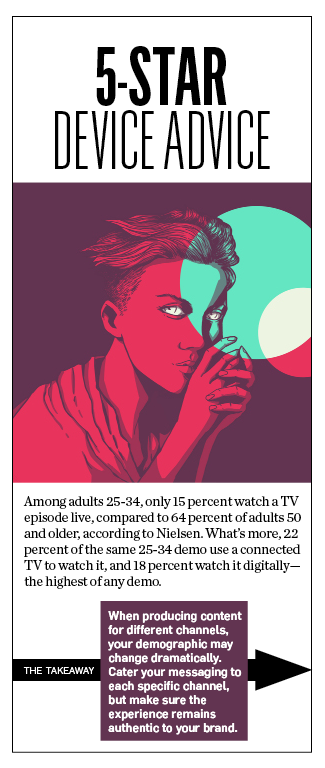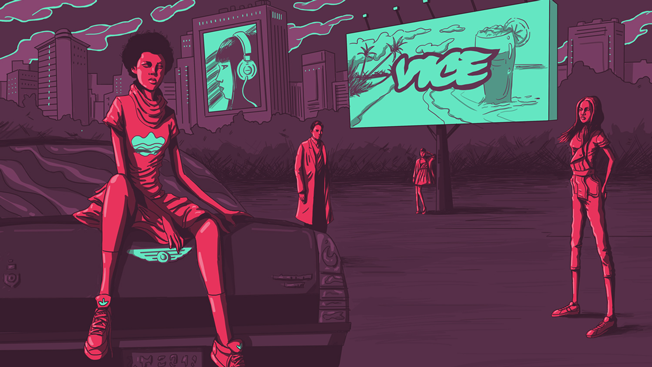At the 2015 NewFronts, Vice Media previewed a slate of 10 TV shows to a room full of ad buyers, press and various attractive 20-somethings. The Brooklyn-based company provided no information—publicly, at least—about where those shows might appear or how brands might buy advertising alongside them. A sizzle reel ended with a screen that said “Coming This Fall.”
Fall came and went. In February, after months of anticipation, the company finally unveiled the home for those shows: Viceland, a 24-hour cable channel launched with A&E. But Vice continues to incorporate a digital sensibility into its programming—one reason it may be presenting again at the NewFronts instead of joining TV programmers with a more traditional Upfront. Having gotten its start as a print magazine, Vice has built a vast and varied media empire by taking a digital-first approach to customer experience. Here are three things marketers can take away from Vice’s transition to TV:

Make content available—everywhere
There’s often a belief in traditional TV that content must be protected. Rights holders and distributors are in a constant fight over where a piece of content can appear and for how long. Issues like exclusivity and “windows” are important. But those rules can end up hurting viewers, who expect to be able to watch whatever they want, wherever they want, whenever they want. With so much content available in today’s “golden age” of TV, if viewers can’t access a clip they want to see, they’ll just move on to something else. They’re less likely than ever to go out of their way to seek something out.
Vice understands that, which is why the company publishes its TV content in as many places as its distributors will allow—Viceland, YouTube, Vice.com, the Vice app, HBO, Vice’s Snapchat Discover channel and on TV stations around the world via licensing deals. The underlying business principle is to sell a piece of content as many times as it possibly can. Often, the company covers the cost of making a piece of content by arranging a sponsorship up front. Then, money made on each additional licensing deal, YouTube ad or banner ad is incremental.
That’s why Vice can make money on its TV channel even if, per reports, ratings are low. CEO Shane Smith has predicted he will be the person to bring young audiences back to analog TV. But if he doesn’t, he has about ten other ways to reach them.
Emphasize native—but in very unique ways
Keeping with its digital ethos, Vice is using its channel to disrupt cable practices such as 16 minutes of ads per hour filled with 30- and 60-second spots. Instead, it built its business model to reduce the overall ad load to 8 minutes of national and 2 minutes of local ads per hour. And it wants to replace the 30-second spot with the kinds of custom, native ad programs that have become increasingly common in digital media. Vice has pioneered these partnerships in print and on its digital properties.
For Vice, it comes down to user experience. Native ads developed from custom brand partnerships are designed to fit seamlessly within the channel’s look and feel. They’re more likely to get viewed and more likely to have a higher recall, which is better for brands in the long term. And they will work across platforms. In that way, Vice is bridging the gap between what advertisers want—quality and scale—and what customers want—content, anywhere and anytime.
And other programs are taking notice—NBC recently announced that it is reducing the ad load on Saturday Night Live, with a greater focus on creating more sponsored content during commercial airtime.
Find a unique voice
Originality is another key to Vice’s strategy. Much like the early days of MTV, Vice’s freewheeling content doesn’t look like anything else on TV. And to make its programming even more inventive, it brought in trailblazing director Spike Jonze as the channel’s creative director.
The truth is, Vice’s programs remain quite true to the hard-edged image the publisher has created across all its properties. Whether it is looking at gay and lesbian life around the world or examining black market economies, it is doing so in a style and format that aligns with what its audience expects.
That doesn’t mean that brands should copy the intentionally shaky camerawork and jump cuts common to Vice. Those hallmarks are true to Vice’s method of storytelling. But what brands can do is raise the bar in the quality of their digital video and find a way to stay true to what their customers expect. Then let viewers watch wherever, whenever and however.









